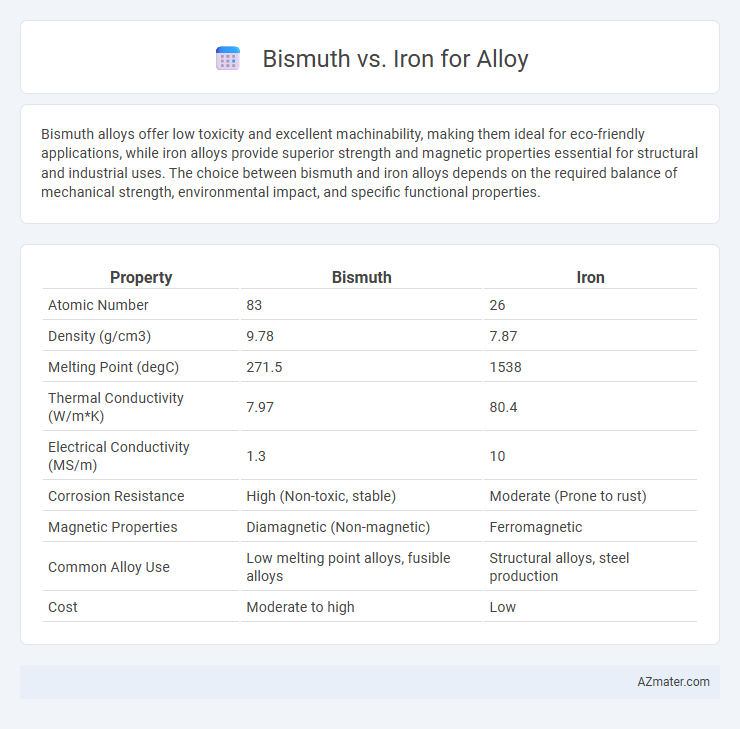Bismuth alloys offer low toxicity and excellent machinability, making them ideal for eco-friendly applications, while iron alloys provide superior strength and magnetic properties essential for structural and industrial uses. The choice between bismuth and iron alloys depends on the required balance of mechanical strength, environmental impact, and specific functional properties.
Table of Comparison
| Property | Bismuth | Iron |
|---|---|---|
| Atomic Number | 83 | 26 |
| Density (g/cm3) | 9.78 | 7.87 |
| Melting Point (degC) | 271.5 | 1538 |
| Thermal Conductivity (W/m*K) | 7.97 | 80.4 |
| Electrical Conductivity (MS/m) | 1.3 | 10 |
| Corrosion Resistance | High (Non-toxic, stable) | Moderate (Prone to rust) |
| Magnetic Properties | Diamagnetic (Non-magnetic) | Ferromagnetic |
| Common Alloy Use | Low melting point alloys, fusible alloys | Structural alloys, steel production |
| Cost | Moderate to high | Low |
Introduction to Bismuth and Iron in Alloys
Bismuth and iron are distinct metals used in alloys, with bismuth known for its low toxicity, high density, and unique crystal structure that offers exceptional brittleness and expansion upon solidification--qualities beneficial in specialized alloys such as fusible plugs and low-melting-point materials. Iron, a widely utilized transition metal, serves as the primary component in steel alloys due to its strength, durability, and magnetic properties, playing a critical role in construction, automotive, and manufacturing industries. Alloying bismuth with iron can introduce specific characteristics like improved machinability and thermal conductivity while maintaining iron's structural integrity.
Chemical and Physical Properties Comparison
Bismuth exhibits a low melting point of 271.5degC and high density of 9.78 g/cm3, making it ideal for low-temperature alloys with unique thermal expansion properties. Iron, with a much higher melting point of 1538degC and density of 7.87 g/cm3, offers superior tensile strength and magnetic properties essential for structural alloys. Chemically, bismuth is corrosion-resistant and non-toxic, whereas iron is prone to oxidation and rust, influencing alloy durability and application environments.
Alloying Behavior: Bismuth vs Iron
Bismuth and iron exhibit markedly different alloying behaviors due to their distinct atomic structures and chemical properties. Bismuth has limited solubility with most metals, resulting in low miscibility and often causing brittleness in alloys, whereas iron forms extensive solid solutions and intermetallic compounds with many elements, enhancing strength and ductility. This fundamental difference makes iron alloys widely versatile for structural applications, while bismuth alloys are specialized for low-melting-point, fusible uses and improved machinability.
Industrial Applications of Bismuth and Iron Alloys
Bismuth alloys are prized in industrial applications for their low toxicity, excellent machinability, and unique properties such as low melting points and high density, making them ideal for use in fire safety devices, pharmaceuticals, and precision casting. Iron alloys, including various grades of steel, dominate heavy industry due to their superior tensile strength, durability, and magnetic properties, essential for construction, automotive manufacturing, and machinery production. The contrasting properties of bismuth and iron alloys allow for specialized uses: bismuth's brittleness and non-magnetic nature suit delicate and environmentally sensitive applications, while iron's robustness supports structural and mechanical demands.
Mechanical Strength and Durability
Bismuth alloys exhibit lower mechanical strength compared to iron alloys, making iron more suitable for applications requiring high load-bearing capacity and structural integrity. Iron's enhanced durability and resistance to wear and fatigue outperform bismuth, which tends to be softer and more brittle under stress. For industries prioritizing mechanical robustness and long-term reliability, iron-based alloys remain the preferred choice over bismuth-based alternatives.
Corrosion Resistance and Environmental Impact
Bismuth alloys demonstrate superior corrosion resistance compared to traditional iron alloys, resisting oxidation and chemical degradation in harsh environments. Unlike iron, which corrodes easily and releases harmful rust compounds, bismuth alloys remain stable, significantly reducing maintenance costs and longevity issues. Environmentally, bismuth is non-toxic and eco-friendly, offering a safer alternative to iron alloys that contribute to soil and water pollution through iron oxide formation.
Melting Points and Casting Performance
Bismuth alloys typically have lower melting points, around 270degC to 300degC, compared to iron which melts at approximately 1538degC, enabling easier casting with reduced energy consumption and faster cycle times. Bismuth alloys exhibit excellent dimensional stability and minimal shrinkage during solidification, enhancing casting precision and reducing defects. Iron alloys require higher temperatures, making them suitable for applications demanding superior mechanical strength but often involve longer cooling times and increased risk of casting porosity.
Safety and Toxicity Considerations
Bismuth alloys are preferred over iron alloys in applications requiring low toxicity and enhanced safety because bismuth is non-toxic and environmentally benign, unlike iron, which can pose health risks when it corrodes or oxidizes releasing rust and metal particles. Bismuth's lower reactivity reduces the risk of harmful chemical reactions and exposure to toxic substances, making it ideal for medical, cosmetic, and food-related alloys. Iron alloys can cause oxidative stress and allergic reactions, especially in sensitive individuals, thus requiring careful handling and protective measures in manufacturing and usage.
Cost Efficiency and Material Availability
Bismuth alloys offer cost efficiency due to low melting points and easy machinability, reducing energy consumption during manufacturing, while iron alloys require higher temperatures, increasing production costs. Material availability favors iron, as it is abundant and widely distributed globally, leading to more stable pricing compared to bismuth, which is rarer and can have volatile market prices. Overall, iron alloys provide consistent supply advantages, whereas bismuth alloys can be more economical in specific applications requiring low melting alloys.
Future Trends in Alloy Development
Bismuth is gaining attention in alloy development for its non-toxic and environmentally friendly properties, making it a preferred substitute for lead in specialty alloys used in automotive and electronics industries. Iron alloys continue to dominate due to their superior strength and cost-effectiveness, with future trends focusing on enhancing corrosion resistance and weight reduction through advanced alloying techniques such as nano-alloying and high-entropy alloys. Emerging research highlights combining bismuth's brittleness reduction capabilities with iron's mechanical strength to create hybrid alloys that optimize durability and sustainability in industrial applications.

Infographic: Bismuth vs Iron for Alloy
 azmater.com
azmater.com